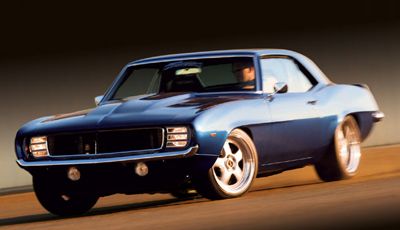
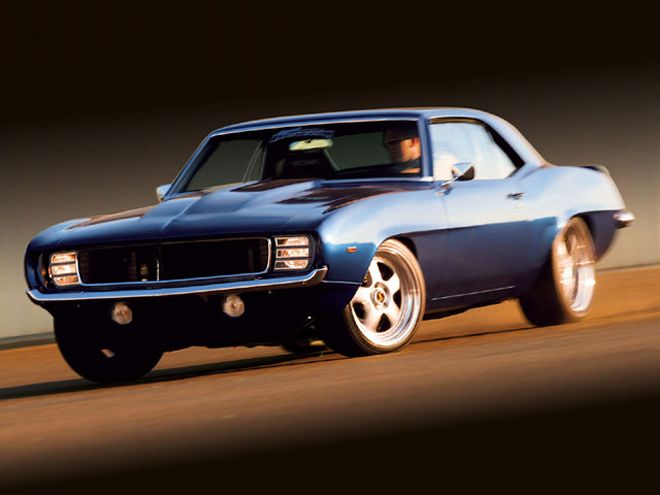
Gearheads in the 21st century have it easy. If we want our classic musclecar to handle better, we only have to flip open a parts catalog, abuse a credit card and before you know it, a bunch of suspension parts will be sitting on the front porch. What we are really doing is trading money for time. We're paying someone else to do the hard work and fix the geometry built into our older cars. However, there was a time when there were no companies fighting to sell us re-worked control arms or other turn-hard goodies. Back in the day, racers and enthusiasts had to work with what they had and what they had wasn't much.
One of those racers was Dick Guldstrand. He has raced on about every track you can think of and back in the late '60s he needed to find a way to make early Camaros and Firebirds handle on a road course. This meant he needed to wrap his mind around the early suspension geometry and figure out a way to make it behave properly in a hard turn.
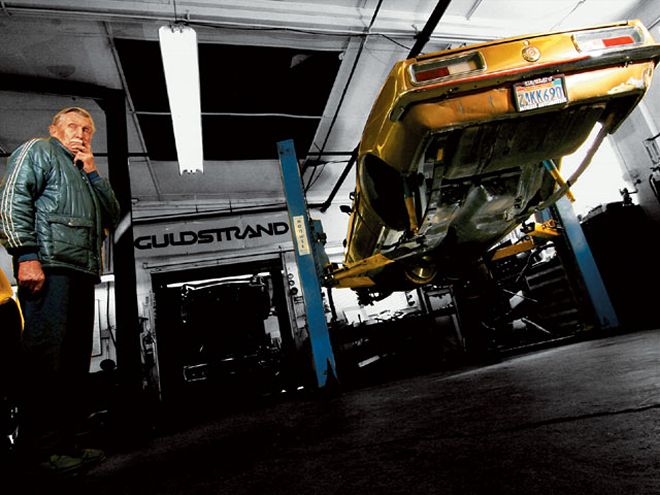
What he figured out was that the stock suspension didn't allow for any camber gain under cornering loads. This caused the contact patches of the front tires to be lessened, which resulted in understeer. The GM engineers preferred understeer to oversteer for a passenger car, since they felt it was safer for your typical driver on the street. To fix this and maximize the contact patch, the outside "loaded" tire needed some negative camber while the inside "unloaded" wheel needed to gain some on the positive side.
You might be wondering how drilling four simple holes could make much difference in how your car handles: It's all about geometry and even the smallest change to a suspension's geometry can have a profound effect on how a car handles. The roll center is the central point about which a car's body rolls under cornering forces. The amount of body roll depends on the leverage effect between the vehicle's roll center and its center of gravity height. The higher the center of gravity and the lower the roll center, the greater the body roll. On the other hand, if you can lower the center of gravity and raise the roll center, your car will have less body roll and become more stable. You could dial in lots of negative static alignment camber, but that will quickly chew up the inside edges of your tires.
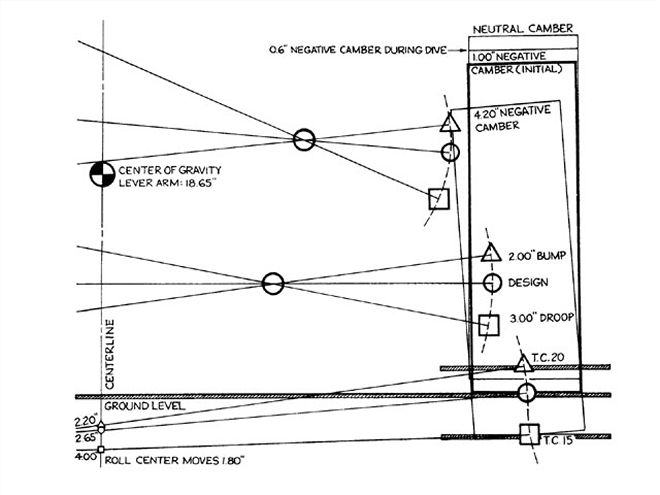 A '67 Camaro Z/28 lowered two inches doesn't have great geometry going on.
A '67 Camaro Z/28 lowered two inches doesn't have great geometry going on.
A better way is to generate camber gain by raising the roll center of your car, however, don't raise it too high or you will get excess tire scrub. Like everything in life, you need a balance.
There are three basic ways to gain camber on your front double A-arm suspension. You can shorten the upper control arms, install a taller spindle, or change the pivot points of your control arms. In this case, relocating the arms is the cheapest option (since you can't pay less than zero). Using the template designed by Guldstrand (for First Generation Camaros and Firebirds) will let you lower the upper control arm pivot points by .75 inch. This raises the front suspension roll center from below ground level, to a point well above the road. This will reduce the angle of the lower control arms and make them more parallel to the ground, giving you a more favorable camber curve. The new holes will also move the top of the spindle rearward .25 inch from stock. This will create more positive caster, which will make the steering feel more "snappy.
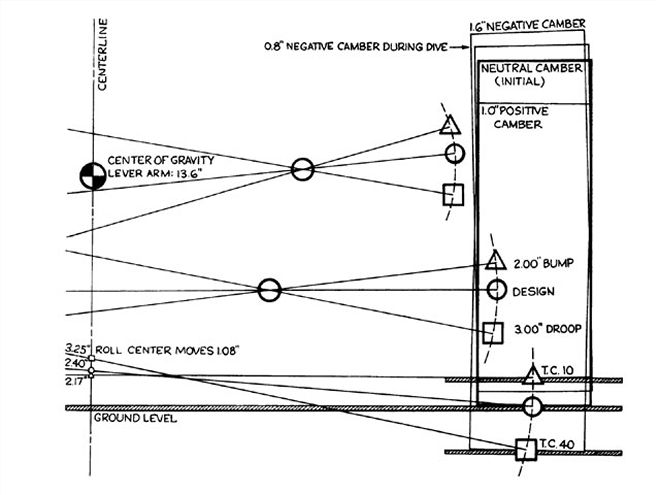 Here you can see what the Guldstrand mod does. Lowering the upper control arms by .75-inch gives a good amount of camber gain.
Here you can see what the Guldstrand mod does. Lowering the upper control arms by .75-inch gives a good amount of camber gain.
According to Dick Guldstrand, "You don't have to go to a shorter spring, but if you do then you'll have a shorter roll moment since your center of gravity will be lower." It should be noted that the lower you go there is an increased chance that you might have to trim away a bit of the mounting tower and the back areas of the upper control arms. On a stock height or slightly lowered car this shouldn't be an issue.
The Ageless Wonder: Dick GuldstrandOnly a few lucky souls experienced the glory days of hot rodding firsthand, and Dick Guldstrand is one of those people. He witnessed the hobby grow before his eyes on the dry lakes and dirt tracks, and he struck up friendships with industry legends like Vic Edelbrock Sr. and Stu Hilborn. To have been around back then, you'd have to be pretty old. While that's true for most people pushing 80, Dick has more youthful energy than people half his age, and his passion for the hobby still burns intensely. He was born in Santa Monica, Calif., and grew up in the Los Angeles area. After crashing his Model A on the dry lakes, he picked up a '27 Model T that he drove throughout high school. In it, he installed the motor out of his Model A and went racing at Culver City and Huntington Beach.
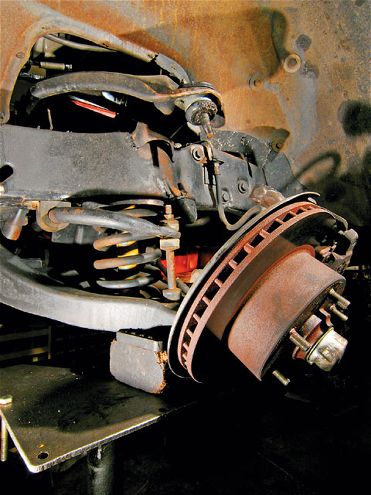 First thing is to remove the upper control arm. Pull the cotter pin from the upper control arm ball joint stud and then loosen the nut.
First thing is to remove the upper control arm. Pull the cotter pin from the upper control arm ball joint stud and then loosen the nut.
After high school, Dick went to UCLA and earned an engineering degree. He then landed a job in the aerospace industry developing technologies that would help put America's first satellite into space. Not one to let work get in the way of having fun, Dick sold his '27 Model T, bought a '56 Corvette, and converted from drag racer to road racer. By the early '60s, his on-track success got him a ride racing a '63 Corvette. From 1963 to 1965, Dick won three consecutive SCCA Pacific Coast Championships, and industry big wigs like Zora Arkus-Duntov took notice. "I wasn't an A.J. Foyt or a Mario Andretti," Dick modestly says. "What I did have was an engineering background and they hired me to make their cars faster. At that time, no one really understood how to modify production chassis to make them handle better."
Chevrolet hired Dick to help develop the Camaro chassis for Trans Am racing in 1967. By that time, Dick had already cut his teeth racing in NASCAR and picked up a few tricks along the way. "Those guys are the greatest cheaters of all time, and they opened my eyes to all kinds of stuff," he says. "I checked the Camaro's suspension geometry, and realized that simply lowering the upper control arm pivot point moved the roll center above the ground, improved camber gain, reduced the rollover moment, and improved the roll axis. Sometimes the little things can make a world of difference." Consequently, the Camaro dominated Trans Am from 1967-1969.
Due to space constraints there's a lot we're leaving out, like Dick's GT-class win at the 1966 Daytona 24-hour race. He also set the GT track record at Lemans in 1967, helped develop Can Am racecars, and his shop has built numerous signature edition Corvettes. Dick sums it up best: "When you're having fun, time just goes by too fast." -Stephen Kim